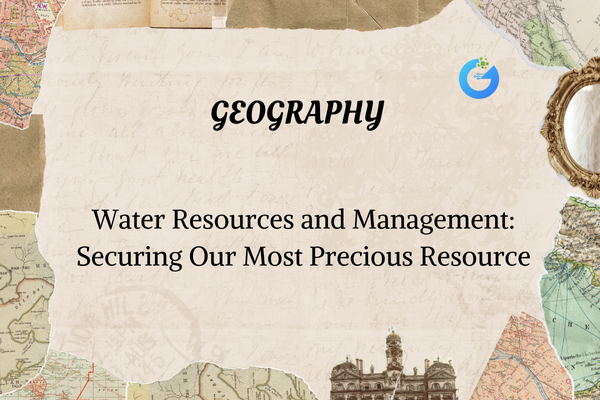Introduction: Why Water Deserves Our Attention
Try going just a single day without water—no brushing your teeth, no cooking meals, no drinking a drop, and no watering plants. Life would come to a standstill.
Even though water covers about 71% of Earth’s surface, only a very small portion—less than 1%—is clean and available for human use. That tiny percentage supports over 8 billion people, countless animals, and entire ecosystems.
In a country like India, where water needs are high and rainfall is seasonal, proper water management is not just important—it’s essential. This lesson will help you understand where our water comes from, why we’re facing a water crisis, and what we can do to conserve and manage it.
expert-led Geography classes – visit our website to learn more
What Are Water Resources?
Water resources are sources of water that we can access and use for different purposes—like drinking, farming, generating electricity, running industries, and maintaining daily life.
Two Main Categories of Water Resources:
| Type | Description | Examples |
| Surface Water | Water found above the ground | Rivers, lakes, ponds, dams |
| Groundwater | Water stored below the Earth’s surface | Wells, tube wells, aquifers |
Although both are important, overuse of either can create serious problems. For example, too much groundwater pumping lowers the water table, while polluted rivers can no longer be used safely.
How Do We Use Water?
Water is part of everything we do—even the electricity that powers your lights or the food on your plate. Here are the major uses:
| Purpose | Real-Life Use |
| Drinking & Domestic | Drinking, bathing, cooking, washing clothes |
| Agriculture | Irrigating crops like rice, wheat, and sugarcane |
| Industries | Cooling machines, processing goods |
| Electricity (Hydropower) | Dams use flowing water to generate electricity |
| Recreation | Boating, swimming, water parks, fishing |
Did you know? Agriculture alone uses about 80% of India’s freshwater resources.
Problems India Faces with Water Resources
Despite having rivers like the Ganga and Brahmaputra, India faces serious water challenges.
| Problem | What’s Happening |
| Water Scarcity | Some areas have less water than needed—especially during summer |
| Pollution | Rivers and lakes are polluted by sewage, chemicals, and plastic |
| Overuse of Groundwater | Excessive pumping for farming is lowering water tables dangerously |
| Wastage | Leaky taps, running water, careless usage waste millions of litres |
| Uneven Distribution | While one region floods, another suffers drought—it’s not balanced |
Rainfall: India’s Natural Water Tank
India gets most of its water from monsoon rains—but this rainfall is seasonal (mostly June to September) and uneven.
| Region | Rainfall Pattern |
| Western Ghats, Assam | Heavy rainfall |
| Rajasthan, Gujarat | Very little rainfall |
| Central & North India | Moderate, but depends heavily on monsoon |
If we don’t store this water properly, it simply flows into the sea and is lost.
How Can We Manage Water Better?
Water management is all about using water wisely and making sure we don’t run out—either today or tomorrow.
Common Water Management Methods
| Method | What It Does |
| Rainwater Harvesting | Collects rainwater from rooftops and open spaces to store it |
| Check Dams & Tanks | Small barriers that store river water locally |
| Drip Irrigation | Sends water directly to plant roots—saving up to 60% water |
| Water Recycling | Cleans and reuses wastewater, especially in factories and cities |
| Watershed Development | Protects and manages water in an entire river basin or hill slope |
Water Conservation: Start Small, Think Big
Saving water starts at home. You don’t need to be a government officer to make a difference—just a little awareness goes a long way.
Everyday Ways to Save Water
- Turn off the tap while brushing your teeth
- Fix leaky faucets and toilets quickly
- Use a bucket for bathing instead of a shower
- Wash vegetables in a bowl, not under running water
- Reuse water from washing vegetables to water plants
Tip: Don’t just use water—respect it.
Core Concepts Table
| Concept | Meaning |
| Groundwater | Water stored underground, used through wells or tube wells |
| Surface Water | Water visible above ground—rivers, lakes, ponds |
| Rainwater Harvesting | Collecting rain to store and reuse later |
| Irrigation | Supplying water to fields for agriculture |
| Watershed | Area of land where all the water flows to a single point |
Frequently Asked Questions (FAQs)
Q1. What is the main source of water in India?
Rainfall from the monsoon is the primary source.
Q2. What are the two main types of water sources?
Surface water and groundwater.
Q3. What is rainwater harvesting?
Collecting and storing rainwater for later use, especially during dry months.
Q4. How can we conserve water in agriculture?
Use methods like drip irrigation and avoid water-intensive crops in dry areas.
Q5. Why is water management important for the future?
Because the population is growing, and water demand is increasing while supply stays limited.
Fun Facts
- India has 4% of the world’s freshwater—but 17% of the world’s people!
- Ancient stepwells like Rani ki Vav in Gujarat show India’s rich water-saving history.
- The Ganga is one of the world’s most sacred and yet most polluted rivers.
- NASA satellites now help track groundwater levels from space.
Conclusion: Water is Wealth—Don’t Waste It
Water gives us life, yet we often take it for granted. From brushing our teeth in the morning to growing the food we eat, water is behind everything.
But if we continue to waste or pollute it, future generations may face a crisis. Now is the time to act.
By learning about water resources and practicing simple conservation habits, we can protect this precious gift of nature—for ourselves and for generations to come.








